Mass Spectrometry-Based Proteomic Analysis of Potential Host Proteins Interacting with N in PRRSV-Infected PAMs
Abstract
1. Introduction
2. Results
2.1. Identification of Nucleocapsid Protein Interactions in the PRRSV-Infected PAMs by Liquid Chromatography Mass Spectrometry
2.2. Functional Analysis of Potential N-Interacting Proteins
2.3. KEGG Pathway Annotation of the Potential Proteins Interacting with Nucleocapsid Protein
2.4. Protein–Protein Interaction (PPI) Network Analysis of N-Interacting Proteins
2.5. Validation of the Proteins That Interact with the Nucleocapsid Protein by Co-IP
2.6. PRRSV May Inhibit Innate Immunity via Nucleocapsid Protein
3. Discussion
4. Materials and Methods
4.1. Cells and Viruses
4.2. Antibodies and Reagents
4.3. Plasmid Construction and Cell Transfection
4.4. RNA Isolation and RT-qPCR
4.5. Western Blotting
4.6. Co-IP
4.7. LC– MS/MS
4.8. Bioinformatics Analysis
4.9. Statistics and Data Analysis
Supplementary Materials
Author Contributions
Funding
Institutional Review Board Statement
Informed Consent Statement
Data Availability Statement
Acknowledgments
Conflicts of Interest
References
- Ma, J.; Ma, L.; Yang, M.; Wu, W.; Feng, W.; Chen, Z. The Function of the PRRSV–Host Interactions and Their Effects on Viral Replication and Propagation in Antiviral Strategies. Vaccines 2021, 9, 364. [Google Scholar] [CrossRef] [PubMed]
- Shi, M.; Lam, T.T.; Hon, C.C.; Murtaugh, M.P.; Davies, P.R.; Hui, R.K.; Li, J.; Wong, L.T.; Yip, C.W.; Jiang, J.W.; et al. Phylogeny-Based Evolutionary, Demographical, and Geographical Dissection of North American Type 2 Porcine Reproductive and Respiratory Syndrome Viruses. J. Virol. 2010, 84, 8700–8711. [Google Scholar] [CrossRef] [PubMed]
- Chen, N.; Cao, Z.; Yu, X.; Deng, X.; Zhao, T.; Wang, L.; Liu, Q.; Li, X.; Tian, K. Emergence of Novel European Geno-type Porcine Reproductive and Respiratory Syndrome Virus in Mainland China. J. Gen. Virol. 2011, 92 Pt 4, 880–892. [Google Scholar] [CrossRef] [PubMed]
- Nan, Y.; Wu, C.; Gu, G.; Sun, W.; Zhang, Y.-J.; Zhou, E.-M. Improved Vaccine against PRRSV: Current Progress and Future Perspective. Front. Microbiol. 2017, 8, 1635. [Google Scholar] [CrossRef] [PubMed]
- Benfield, D.A.; Nelson, E.; Collins, J.E.; Harris, L.; Goyal, S.M.; Robison, D.; Christianson, W.T.; Morrison, R.B.; Gorcyca, D.; Chladek, D. Characterization of Swine Infertility and Respiratory Syndrome (SIRS) Virus (Isolate ATCC VR-2332). J. Vet. Diagn. Investig. 1992, 4, 127–133. [Google Scholar] [CrossRef] [PubMed]
- Cavanagh, D. Nidovirales: A New Order Comprising Coronaviridae and Arteriviridae. Arch. Virol. 1997, 142, 629–633. [Google Scholar] [PubMed]
- Nelsen, C.J.; Murtaugh, M.P.; Faaberg, K.S. Porcine Reproductive and Respiratory Syndrome Virus Comparison: Divergent Evolution on Two Continents. J. Virol. 1999, 73, 270–280. [Google Scholar] [CrossRef] [PubMed]
- Li, Y.; Treffers, E.E.; Napthine, S.; Tas, A.; Zhu, L.; Sun, Z.; Bell, S.; Mark, B.L.; van Veelen, P.A.; van Hemert, M.J.; et al. Transactivation of Programmed Ribosomal Frameshifting by a Viral Protein. Proc. Natl. Acad. Sci. USA 2014, 111, E2172–E2181. [Google Scholar] [CrossRef]
- Music, N.; Gagnon, C.A. The Role of Porcine Reproductive and Respiratory Syndrome (Prrs) Virus Structural and Non-Structural Proteins in Virus Pathogenesis. Anim. Health Res. Rev. 2010, 11, 135–163. [Google Scholar] [CrossRef]
- Chen, X.-X.; Qiao, S.; Li, R.; Wang, J.; Li, X.; Zhang, G. Evasion Strategies of Porcine Reproductive and Respiratory Syndrome virus. Front. Microbiol. 2023, 14, 1140449. [Google Scholar] [CrossRef]
- Luo, R.; Fang, L.; Jiang, Y.; Jin, H.; Wang, Y.; Wang, D.; Chen, H.; Xiao, S. Activation of Nf-Κb by Nucleocapsid Protein of the Porcine Reproductive and Respiratory Syndrome Virus. Virus Genes. 2011, 42, 76–81. [Google Scholar] [CrossRef] [PubMed]
- Hoenen, T.; Groseth, A. Virus-Host Cell Interactions. Cells 2022, 11, 804. [Google Scholar] [CrossRef] [PubMed]
- Jourdan, S.S.; Osorio, F.; Hiscox, J.A. An Interactome Map of the Nucleocapsid Protein from a Highly Patho-genic North American Porcine Reproductive and Respiratory Syndrome Virus Strain Generated Using Silac-Based Quantitative Proteomics. Proteomics 2012, 12, 1015–1023. [Google Scholar] [CrossRef] [PubMed]
- Szklarczyk, D.; Gable, A.L.; Lyon, D.; Junge, A.; Wyder, S.; Huerta-Cepas, J.; Simonovic, M.; Doncheva, N.T.; Morris, J.H.; Bork, P.; et al. String V11: Protein-Protein Association Networks with Increased Coverage, Supporting Functional Discovery in Genome-Wide Experimental Datasets. Nucleic Acids Res. 2019, 47, D607–D613. [Google Scholar] [CrossRef] [PubMed]
- Bonaventure, B.; Goujon, C. Dexh/D-Box Helicases at the Frontline of Intrinsic and Innate Immunity against Viral Infections. J. Gen. Virol. 2022, 103, 01766. [Google Scholar] [CrossRef] [PubMed]
- Zhang, Z.; Kim, T.; Bao, M.; Facchinetti, V.; Jung, S.Y.; Ghaffari, A.A.; Qin, J.; Cheng, G.; Liu, Y.-J. DDX1, DDX21, and DHX36 Helicases Form a Complex with the Adaptor Molecule TRIF to Sense dsRNA in Dendritic Cells. Immunity 2011, 34, 866–878. [Google Scholar] [CrossRef] [PubMed]
- Oshiumi, H.; Sakai, K.; Matsumoto, M.; Seya, T. Dead/H Box 3 (Ddx3) Helicase Binds the Rig-I Adaptor Ips-1 to up-Regulate Ifn-Beta-Inducing Potential. Eur. J. Immunol. 2010, 40, 940–948. [Google Scholar] [CrossRef] [PubMed]
- Cargill, M.; Venkataraman, R.; Lee, S. DEAD-Box RNA Helicases and Genome Stability. Genes 2021, 12, 1471. [Google Scholar] [CrossRef] [PubMed]
- Goldstone, D.C.; Ennis-Adeniran, V.; Hedden, J.J.; Groom, H.C.T.; Rice, G.I.; Christodoulou, E.; Walker, P.A.; Kelly, G.; Haire, L.F.; Yap, M.W.; et al. HIV-1 Restriction Factor SAMHD1 is a Deoxynucleoside Triphosphate Triphosphohydrolase. Nature 2011, 480, 379–382. [Google Scholar] [CrossRef]
- Powell, R.D.; Holland, P.J.; Hollis, T.; Perrino, F.W. Aicardi-Goutieres Syndrome Gene and Hiv-1 Restriction Factor Samhd1 Is a Dgtp-Regulated Deoxynucleotide Triphosphohydrolase. J. Biol. Chem. 2011, 286, 43596–43600. [Google Scholar] [CrossRef]
- Chen, S.; Bonifati, S.; Qin, Z.; Gelais, C.S.; Kodigepalli, K.M.; Barrett, B.S.; Kim, S.H.; Antonucci, J.M.; Ladner, K.J.; Buzovetsky, O.; et al. Samhd1 Suppresses Innate Immune Responses to Viral Infections and Inflammatory Stimuli by Inhibiting the Nf-Κb and Interferon Pathways. Proc. Natl. Acad. Sci. USA 2018, 115, E3798–E3807. [Google Scholar] [CrossRef] [PubMed]
- Espada, C.E.; Gelais, C.S.; Bonifati, S.; Maksimova, V.V.; Cahill, M.P.; Kim, S.H.; Wu, L. Traf6 and Tak1 Con-tribute to Samhd1-Mediated Negative Regulation of Nf-Κb Signaling. J. Virol. 2021, 95, e01970-20. [Google Scholar] [CrossRef] [PubMed]
- García-de-Gracia, F.; Gaete-Argel, A.; Riquelme-Barrios, S.; Pereira-Montecinos, C.; Rojas-Araya, B.; Aguilera, P.; Oyarzún-Arrau, A.; Rojas-Fuentes, C.; Acevedo, M.L.; Chnaiderman, J.; et al. Cbp80/20-Dependent Translation Initiation Factor (Ctif) Inhibits Hiv-1 Gag Synthesis by Targeting the Function of the Viral Protein Rev. RNA Biol. 2021, 18, 745–758. [Google Scholar] [CrossRef] [PubMed]
- Abaeva, I.S.; Arhab, Y.; Miścicka, A.; Hellen, C.U.T.; Pestova, T.V. In Vitro Reconstitution of Sars-Cov-2 Nsp1-Induced Mrna Cleavage Reveals the Key Roles of the N-Terminal Domain of Nsp1 and the Rrm Domain of Eif3g. Genes Dev. 2023, 37, 844–860. [Google Scholar] [CrossRef] [PubMed]
- You, F.; Sun, H.; Zhou, X.; Sun, W.; Liang, S.; Zhai, Z.; Jiang, Z. PCBP2 Mediates Degradation of the Adaptor MAVS via the HECT Ubiquitin Ligase AIP4. Nat. Immunol. 2009, 10, 1300–1308. [Google Scholar] [CrossRef] [PubMed]
- Gu, H.; Yang, J.; Zhang, J.; Song, Y.; Zhang, Y.; Xu, P.; Zhu, Y.; Wang, L.; Zhang, P.; Li, L.; et al. PCBP2 Maintains Antiviral Signaling Homeostasis by Regulating cGAS Enzymatic Activity via Antagonizing Its Condensation. Nat. Commun. 2022, 13, 1564. [Google Scholar] [CrossRef] [PubMed]
- Sagong, M.; Lee, C. Porcine Reproductive and Respiratory Syndrome virus Nucleocapsid Protein Modulates Interferon-β Production by Inhibiting IRF3 Activation in Immortalized Porcine Alveolar Macrophages. Arch. Virol. 2011, 156, 2187–2195. [Google Scholar] [CrossRef]
- Luo, X.; Chen, X.-X.; Qiao, S.; Li, R.; Xie, S.; Zhou, X.; Deng, R.; Zhou, E.-M.; Zhang, G. Porcine Reproductive and Respiratory Syndrome Virus Enhances Self-Replication via AP-1-Dependent Induction of SOCS1. J. Immunol. 2020, 204, 394–407. [Google Scholar] [CrossRef]
- Jing, H.; Zhou, Y.; Fang, L.; Ding, Z.; Wang, D.; Ke, W.; Chen, H.; Xiao, S. Dexd/H-Box Helicase 36 Signaling Via Myeloid Differentiation Primary Response Gene 88 Contributes to Nf-Κb Activation to Type 2 Porcine Reproductive and Respiratory Syndrome Virus Infection. Front. Immunol. 2017, 8, 1365. [Google Scholar] [CrossRef]
- Dong, S.; Liu, L.; Wu, W.; Armstrong, S.D.; Xia, D.; Nan, H.; Hiscox, J.A.; Determination, H.C. of the Interac-tome of Non-Structural Protein12 from Highly Pathogenic Porcine Reproductive and Respiratory Syndrome Virus with Host Cellular Proteins Using High Throughput Proteomics and Identification of Hsp70 as a Cellular Factor for Virus Replication. J. Proteom. 2016, 146, 58–69. [Google Scholar] [CrossRef]
- Song, T.; Fang, L.; Wang, D.; Zhang, R.; Zeng, S.; An, K.; Chen, H.; Xiao, S. Quantitative Interactome Reveals That Porcine Reproductive and Respiratory Syndrome Virus Nonstructural Protein 2 Forms a Complex with Viral Nucle-ocapsid Protein and Cellular Vimentin. J. Proteom. 2016, 142, 70–81. [Google Scholar] [CrossRef] [PubMed]
- Wang, L.; Zhou, L.; Zhang, H.; Li, Y.; Ge, X.; Guo, X.; Yu, K.; Yang, H. Interactome Profile of the Host Cellular Pro-teins and the Nonstructural Protein 2 of Porcine Reproductive and Respiratory Syndrome Virus. PLoS ONE 2014, 9, e99176. [Google Scholar]
- Wang, Q.; Li, Y.; Dong, H.; Wang, L.; Peng, J.; An, T.; Yang, X.; Tian, Z.; Cai, X. Identification of Host Cellular Pro-teins That Interact with the M Protein of a Highly Pathogenic Porcine Reproductive and Respiratory Syndrome Virus Vaccine Strain. Virol. J. 2017, 14, 39. [Google Scholar] [CrossRef] [PubMed]
- Zhang, M.; Zakhartchouk, A. Characterization of the Interactome of the Porcine Reproductive and Respiratory Syndrome virus Glycoprotein-5. Arch. Virol. 2018, 163, 1595–1605. [Google Scholar] [CrossRef] [PubMed]
- Li, W.; Wang, Y.; Zhang, M.; Zhao, S.; Wang, M.; Zhao, R.; Chen, J.; Zhang, Y.; Xia, P. Mass Spectrometry-Based Proteomic Analysis of Potential Host Proteins Interacting with GP5 in PRRSV-Infected PAMs. Int. J. Mol. Sci. 2024, 25, 2778. [Google Scholar] [CrossRef] [PubMed]
- Dejgaard, K.; Leffers, H. Characterisation of the Nucleic-Acid-Binding Activity of Kh Domains. Different Properties of Different Domains. Eur. J. Biochem. 1996, 241, 425–431. [Google Scholar] [CrossRef] [PubMed]
- Fenn, S.; Du, Z.; Lee, J.K.; Tjhen, R.; Stroud, R.M.; James, T.L. Crystal Structure of the Third Kh Domain of Human Poly(C)-Binding Protein-2 in Complex with a C-Rich Strand of Human Telomeric DNA at 1.6 a Resolution. Nucleic Acids Res. 2007, 35, 2651–2660. [Google Scholar] [CrossRef]
- Xia, P.; Wang, S.; Xiong, Z.; Ye, B.; Huang, L.-Y.; Han, Z.-G.; Fan, Z. IRTKS Negatively Regulates Antiviral Immunity through PCBP2 Sumoylation-Mediated MAVS Degradation. Nat. Commun. 2015, 6, 8132. [Google Scholar] [CrossRef] [PubMed]
- Fujimura, K.; Kano, F.; Murata, M. Identification of PCBP2, a Facilitator of IRES-Mediated Translation, as a Novel Constituent of Stress Granules and Processing Bodies. RNA 2008, 14, 425–431. [Google Scholar] [CrossRef]
- Smirnova, V.V.; Shestakova, E.D.; Bikmetov, D.V.; Chugunova, A.A.; Osterman, I.A.; Serebryakova, M.V.; Sergeeva, O.V.; Zatsepin, T.S.; Shatsky, I.N.; Terenin, I.M. eIF4G2 Balances Its Own mRNA Translation via a PCBP2-Based Feedback Loop. RNA 2019, 25, 757–767. [Google Scholar] [CrossRef]
- Makeyev, A.V.; Liebhaber, S.A. The Poly(C)-Binding Proteins: A Multiplicity of Functions and a Search for Mechanisms. RNA 2002, 8, 265–278. [Google Scholar] [CrossRef] [PubMed]
- Spear, A.; Sharma, N.; Flanegan, J.B. Protein-Rna Tethering: The Role of Poly(C) Binding Protein 2 in Poliovirus Rna Replication. Virology 2008, 374, 280–291. [Google Scholar] [CrossRef] [PubMed][Green Version]
- Wang, L.; He, Q.; Gao, Y.; Guo, X.; Ge, X.; Zhou, L.; Yang, H. Interaction of Cellular Poly(C)-Binding Protein 2 with Nonstructural Protein 1β Is Beneficial to Chinese Highly Pathogenic Porcine Reproductive and Respiratory Syn-drome Virus Replication. Virus Res. 2012, 169, 222–230. [Google Scholar] [CrossRef] [PubMed]
- Cui, Z.; Zhou, L.; Zhao, S.; Li, W.; Li, J.; Chen, J.; Zhang, Y.; Xia, P. The Host E3-Ubiquitin Ligase TRIM28 Impedes Viral Protein GP4 Ubiquitination and Promotes PRRSV Replication. Int. J. Mol. Sci. 2023, 24, 10965. [Google Scholar] [CrossRef] [PubMed]
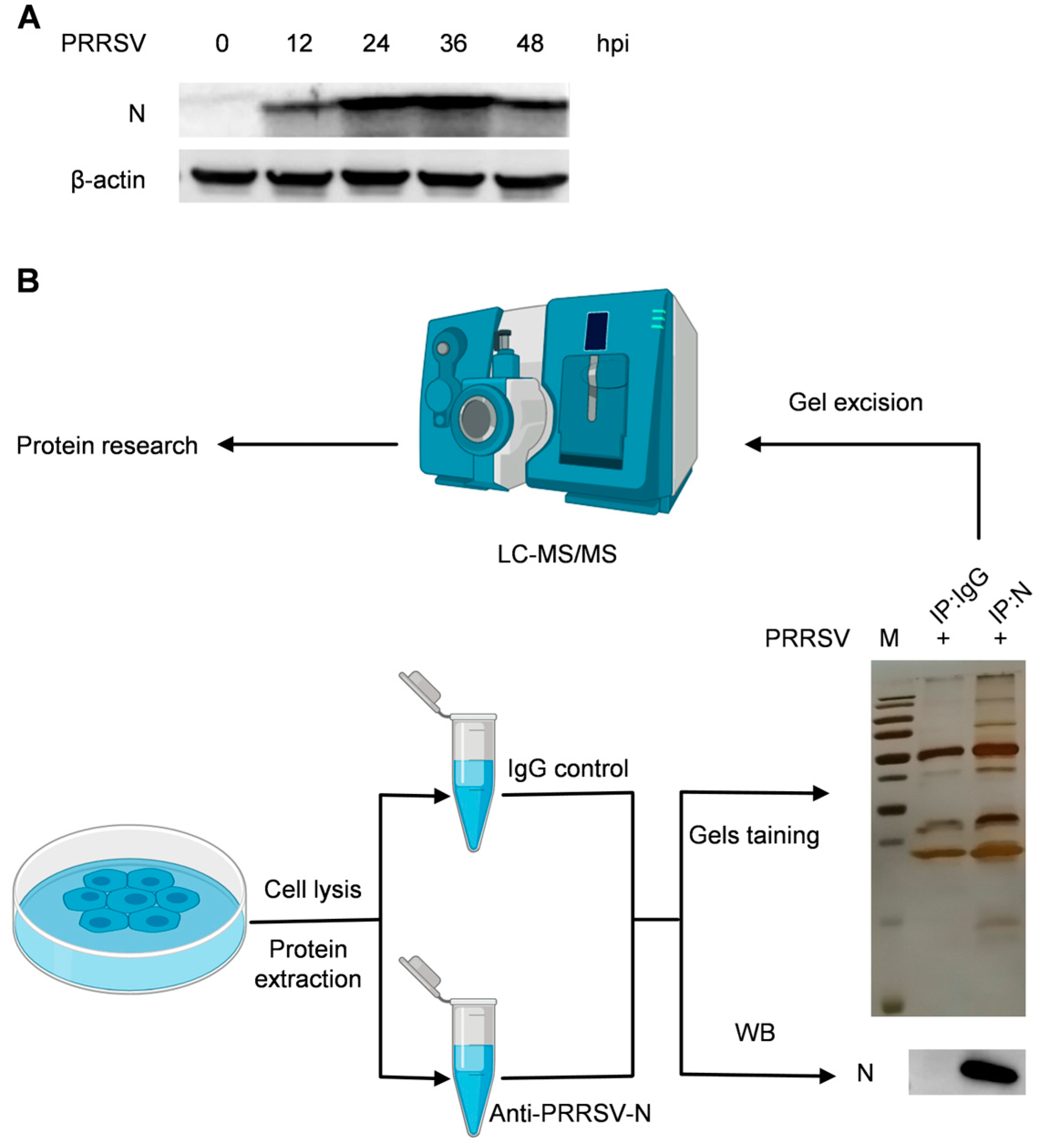
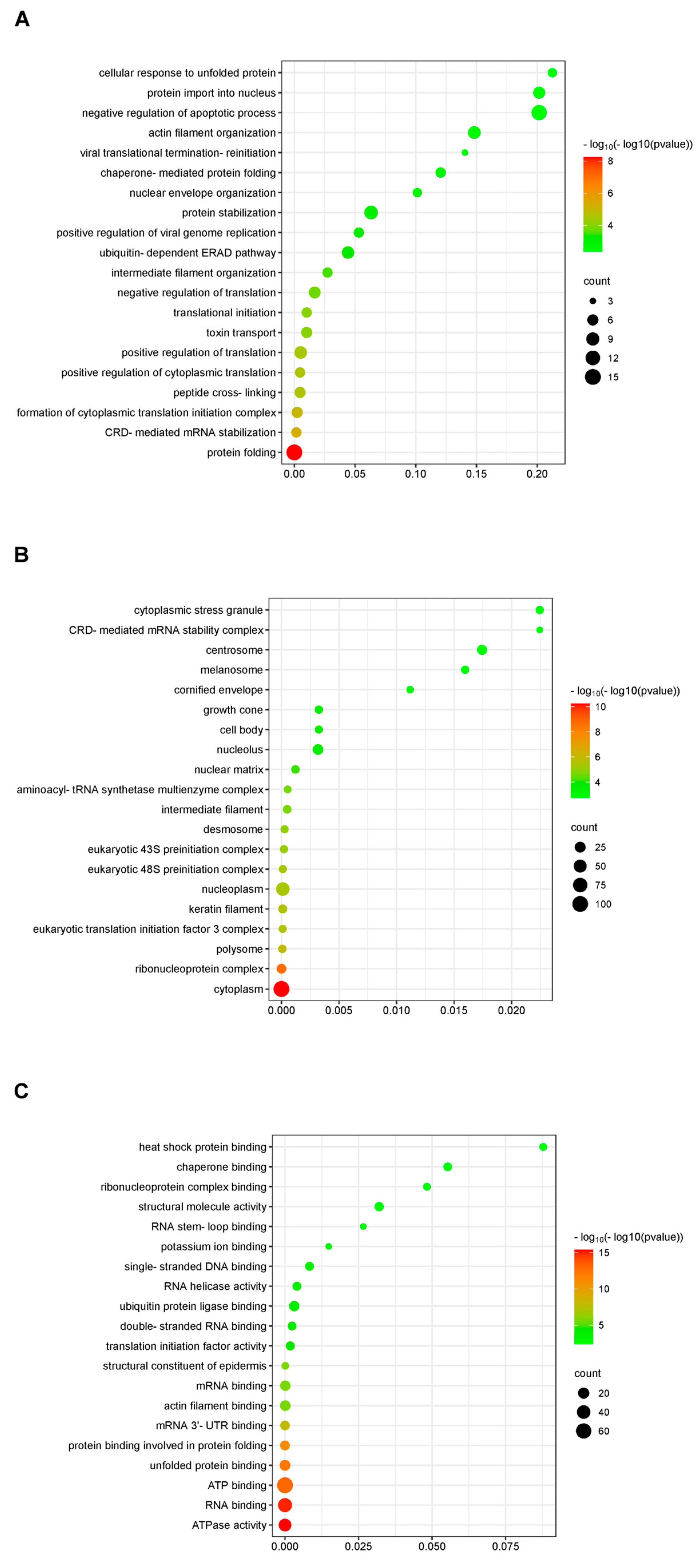

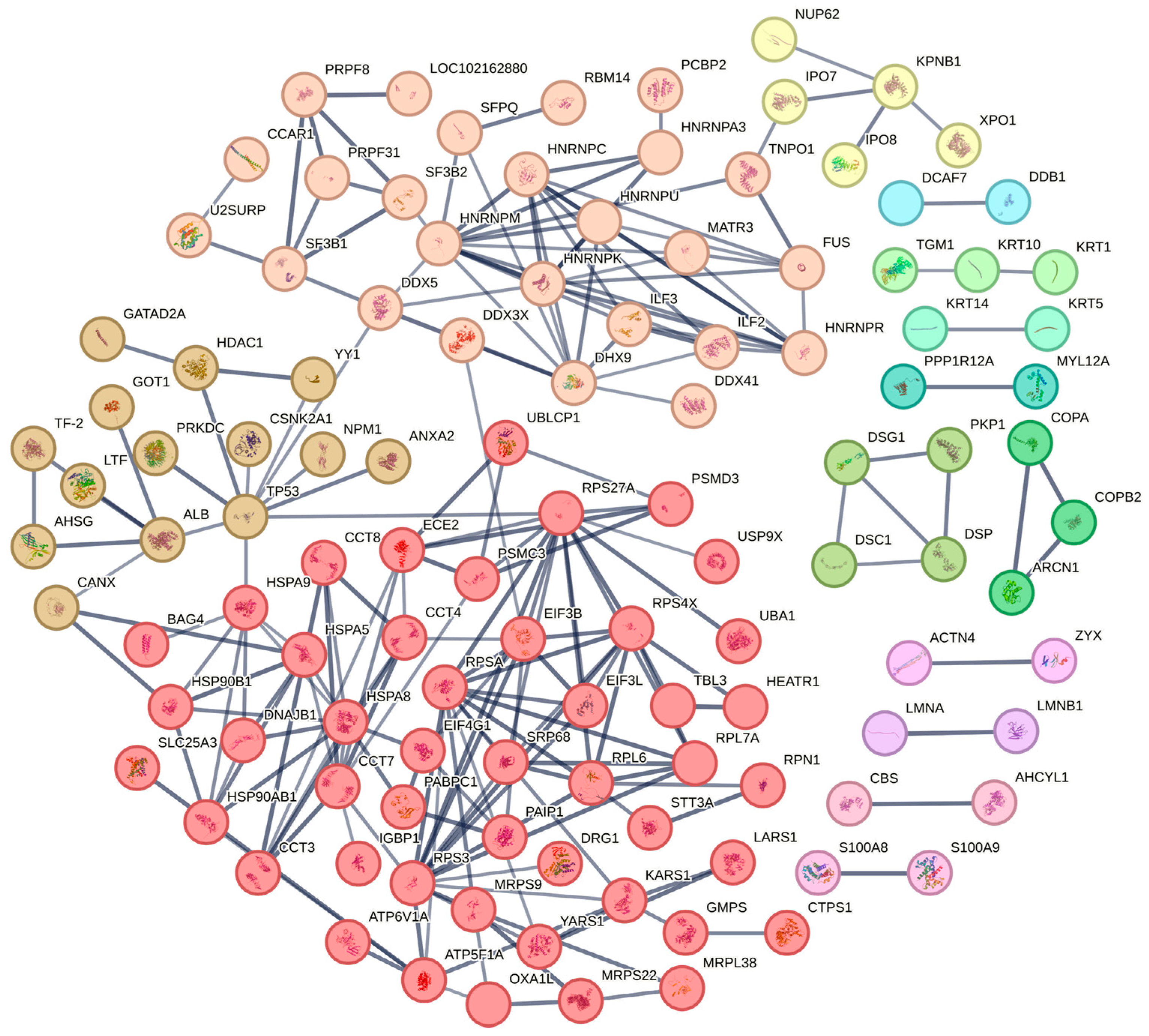
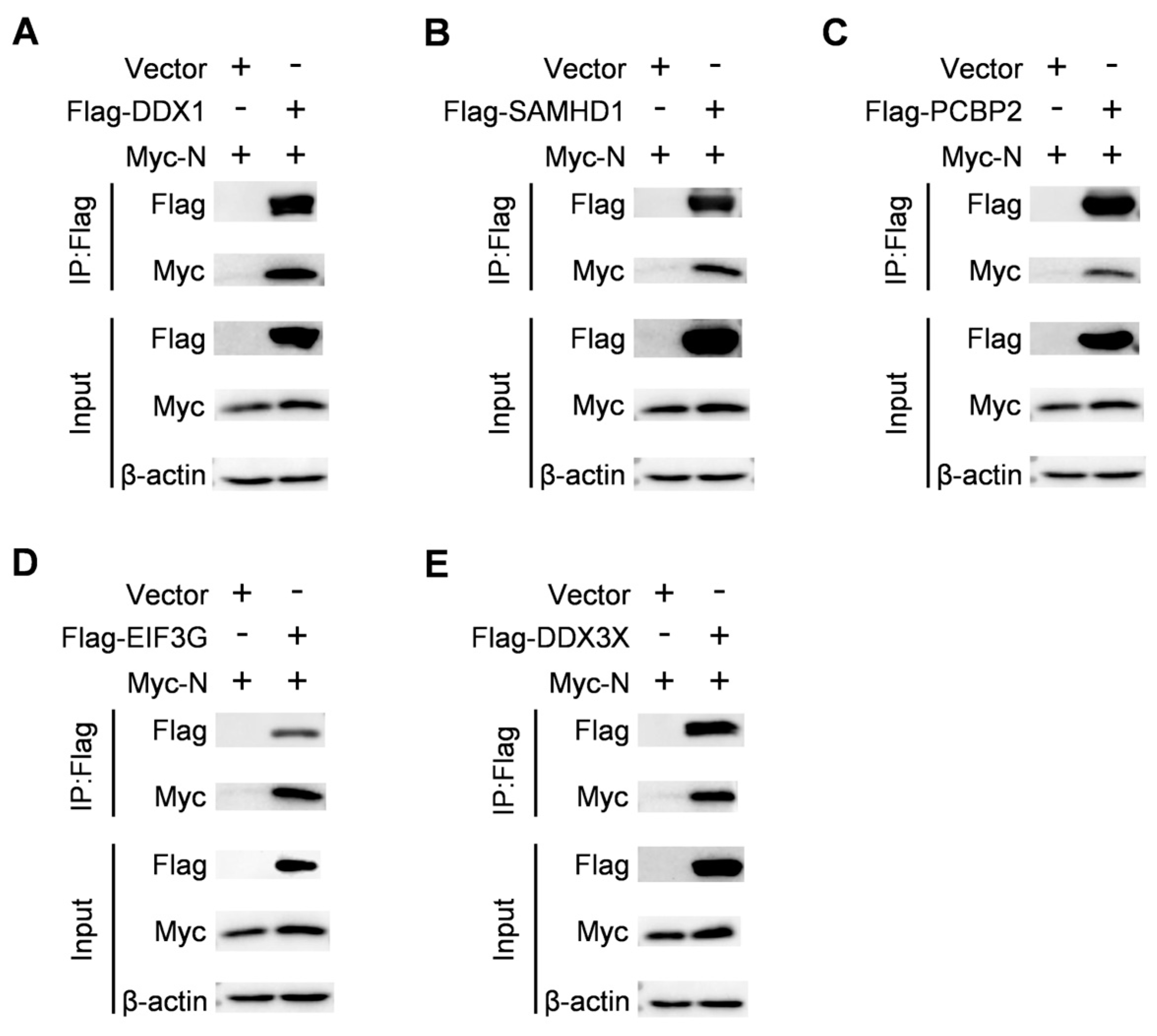
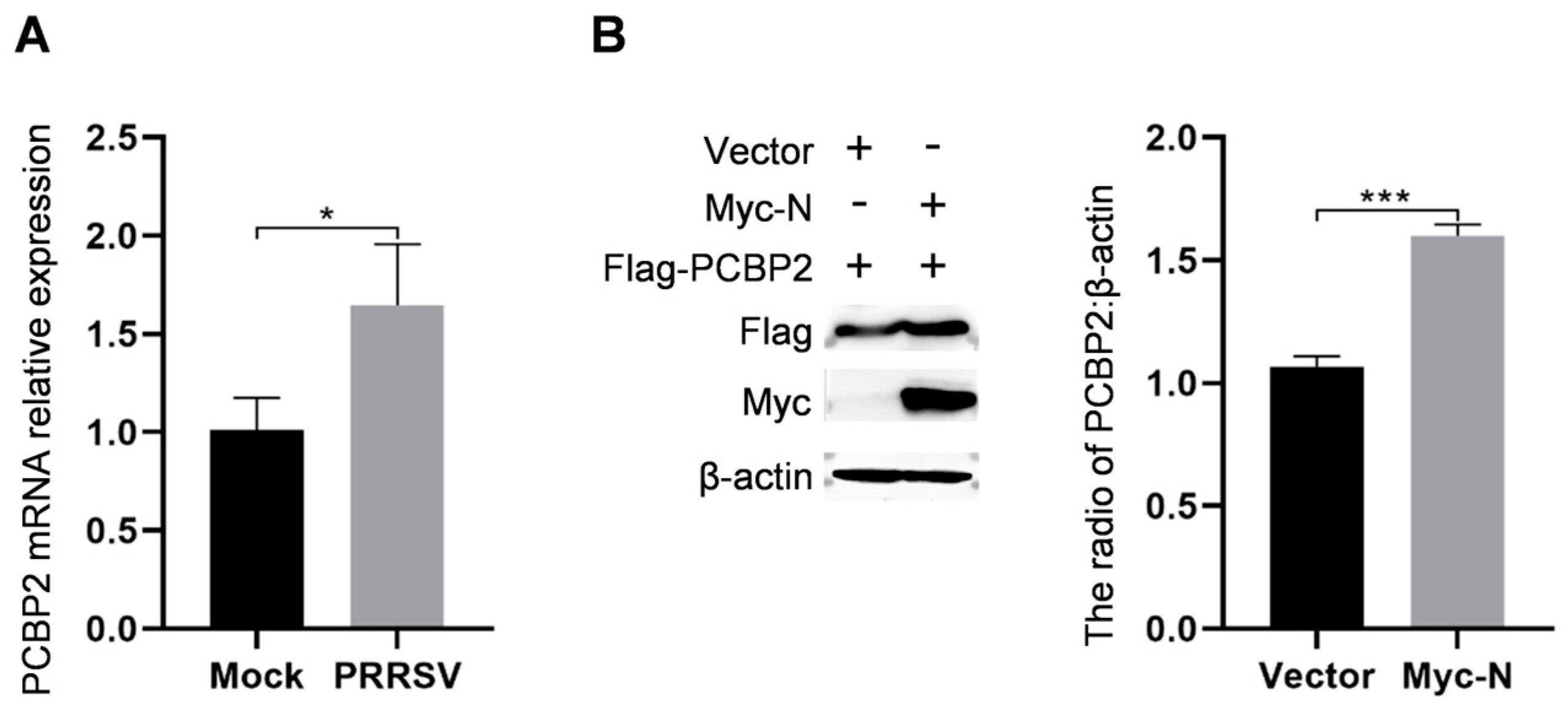
Disclaimer/Publisher’s Note: The statements, opinions and data contained in all publications are solely those of the individual author(s) and contributor(s) and not of MDPI and/or the editor(s). MDPI and/or the editor(s) disclaim responsibility for any injury to people or property resulting from any ideas, methods, instructions or products referred to in the content. |
© 2024 by the authors. Licensee MDPI, Basel, Switzerland. This article is an open access article distributed under the terms and conditions of the Creative Commons Attribution (CC BY) license (https://creativecommons.org/licenses/by/4.0/).
Share and Cite
Zhao, S.; Li, F.; Li, W.; Wang, M.; Wang, Y.; Zhang, Y.; Xia, P.; Chen, J. Mass Spectrometry-Based Proteomic Analysis of Potential Host Proteins Interacting with N in PRRSV-Infected PAMs. Int. J. Mol. Sci. 2024, 25, 7219. https://doi.org/10.3390/ijms25137219
Zhao S, Li F, Li W, Wang M, Wang Y, Zhang Y, Xia P, Chen J. Mass Spectrometry-Based Proteomic Analysis of Potential Host Proteins Interacting with N in PRRSV-Infected PAMs. International Journal of Molecular Sciences. 2024; 25(13):7219. https://doi.org/10.3390/ijms25137219
Chicago/Turabian StyleZhao, Shijie, Fahao Li, Wen Li, Mengxiang Wang, Yueshuai Wang, Yina Zhang, Pingan Xia, and Jing Chen. 2024. "Mass Spectrometry-Based Proteomic Analysis of Potential Host Proteins Interacting with N in PRRSV-Infected PAMs" International Journal of Molecular Sciences 25, no. 13: 7219. https://doi.org/10.3390/ijms25137219
APA StyleZhao, S., Li, F., Li, W., Wang, M., Wang, Y., Zhang, Y., Xia, P., & Chen, J. (2024). Mass Spectrometry-Based Proteomic Analysis of Potential Host Proteins Interacting with N in PRRSV-Infected PAMs. International Journal of Molecular Sciences, 25(13), 7219. https://doi.org/10.3390/ijms25137219




